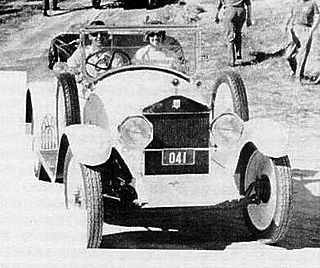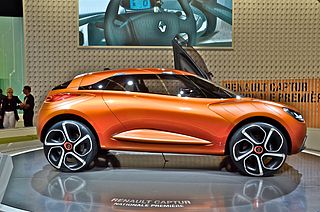
Holden, formerly known as General Motors-Holden, was an Australian subsidiary company of General Motors. It was an Australian automobile manufacturer, importer, and exporter which sold cars under its own marque in Australia. In its last three years, it switched entirely to importing cars. It was headquartered in Port Melbourne, with major industrial operations in the states of South Australia and Victoria. The 164-year-old company ceased trading at the end of 2020.

The straight-six engine is a piston engine with six cylinders arranged in a straight line along the crankshaft. A straight-six engine has perfect primary and secondary engine balance, resulting in fewer vibrations than other designs of six or less cylinders.

Zeta is a marque of automobile which was produced in Australia from 1963 to 1965 by South Australian manufacturing company Lightburn & Co.

In the automotive industry, rebadging is a form of market segmentation used by automobile manufacturers around the world. To allow for product differentiation without designing or engineering a new model or brand, a manufacturer creates a distinct automobile by applying a new "badge" or trademark to an existing product line.

The Leyland P76 is a large car that was produced by Leyland Australia, the Australian subsidiary of British Leyland. Featuring what was described at the time as the "standard Australian wheelbase of 111 inches", it was intended to provide the company with a genuine rival to large local models like the Ford Falcon, the Holden Kingswood, and the Chrysler Valiant. But, due to the first real fuel crisis and demand far exceeding the supply, Leyland rushed the assembly process with the first of the P76s to come off the assembly line, resulting in poor build quality and some reliability problems. The combination of the rushed assembly, fuel crisis and strikes at the component manufacturers' factories, resulted in the Leyland P76 being labelled a lemon, despite receiving the Wheels magazine Car of the Year in 1973. By 1974, sales of the P76 had slumped and BMC decided to end the production of the P76. Although the P76 has been labelled a lemon in Australian motoring history, it is viewed by some as an iconic Australian car and has a loyal following. Elton John briefly owned one and called it ‘Austin’ after his great grandfather Sir Austin Minivan.

The Holden Torana is a mid-sized car that was manufactured by Holden from 1967 to 1980. The name apparently comes from an word meaning "to fly" in an unconfirmed Aboriginal Australian language. The original HB series Torana was released in 1967 and was a four-cylinder compact vehicle closely based on the British Vauxhall Viva HB series of 1966 - 1970.

The Australian Six was an Australian automobile manufactured from 1919 to 1925. It was a grandiose attempt to compete against imported cars from the United States, and was produced from a mixture of local and imported parts. Vehicles featured a conventional chassis layout and a choice of five bodies, locally made under the motto 'Made in Australia, by Australians, for Australia'. Most models were fitted with Rutenber Straight-6 engines and Grant Lees or Muncie gearboxes; some, however, had imported OHV Ansted engines instead. Before 1919 the factory was at the Sydney Harbour side suburb of Rushcutters Bay, New South Wales, it then moved to Ashfield until 1924. The company was forced to shut down production after some 500 cars were built; this was due mainly to high local construction costs. The final few cars were made by the Harkness and Hillier hire car company in Sydney. Only four Australian Sixes are thought to survive, one in the Powerhouse Museum automobile collection in Sydney, one in the York Motor Museum, York, Western Australia, this is one of the first six built without a chassis number in the first factory, one in the National Museum in Canberra and one in Birdwood Museum, South Australia.

The Nissan Bluebird is a compact car with a model name introduced in 1957. It has been Nissan's most internationally recognized sedan, in multiple body styles, and is known for its dependability and durability. The Bluebird originated from Nissan's first vehicles, dating to the early 1900s, and its traditional competitor became the Toyota Corona. The Bluebird was positioned to compete with the Corona, as the Corona was developed to continue offering a sedan used as a taxi since Toyota Crown was growing in size. Every generation of the Bluebird has been available as a taxi, duties that are shared with base level Nissan Cedrics. It is one of the longest-running nameplates from a Japanese automaker. It spawned most of Nissan's products sold internationally, and has been known by a number of different names and bodystyles, including the 160J/710/Violet/Auster/Stanza line.

A panel van, also known as a blind van, car-derived van or sedan delivery, is a small cargo vehicle with a passenger car chassis, typically with a single front bench seat and no side windows behind the B-pillar. Panel vans are smaller than panel trucks or cargo vans, both of which use body-on-frame truck chassis.

A ute, originally an abbreviation for "utility" or "coupé utility", is a term used in Australia and New Zealand to describe vehicles with a tonneau behind the passenger compartment, that can be driven with a regular driver's license.

The Holden was a full-sized car produced by the company of the same name across 5 generations from 1948 until 1984. The Holden is also commonly referred to by their model designation and also the H Series. The Holden was introduced to be Australia's car, being the first full scale produced automobile exclusive to the country. Prior to which, General Motors Holden's Ltd. assembled imported CKD kits from overseas General Motors subsidiaries such as Chevrolet, Buick, Vauxhall and more. And the only other cars built in the country being Ford and Chrysler vehicle bodys fitted to imported chassis. The Holden was an instant success among Australians, being the first production car built solely for Australia's unique, rough roads.

The Auto Expo is a biennial automotive show held in Greater Noida, NCR, India.

The Holden HQ series is a range of automobiles that was produced by Holden in Australia from 1971 to 1974. The HQ was released on 15 July 1971, replacing the Holden HG series. It was the first ground-up redesign of the Holden line since its original release in 1948, and included an all-new body, chassis, and suspension. The HQ was later developed into a series of successor models, finally ending production when the WB series was discontinued in 1984.

The 1974 Hardie-Ferodo 1000 was an endurance race for Group C Touring Cars, held at the Mount Panorama Circuit near Bathurst in New South Wales, Australia on 6 October 1974. The race was Round 3 of the 1974 Australian Manufacturers' Championship and was the 15th in a sequence of annual “Bathurst 1000” races commencing with the 1960 Armstrong 500.

A substantial car industry was created in Australia in the 20th century through the opening of Australian plants by international manufacturers. The first major carmaker was Ford Australia and the first Australian-designed mass production car was manufactured by Holden in 1948. Australian manufacture of cars rose to a maximum of almost half a million in the 1970s and still exceeded 400,000 in 2004. Australia was best known for the design and production of 'large' sized passenger vehicles. By 2009 total production had fallen to around 175,000 and the Australian market was dominated by cars imported from Asia and Europe.

The automotive industry in South Korea is the fifth-largest in the world as measured by automobile unit production and also the sixth-largest by automobile export volume.

A coupé utility is a vehicle with a passenger compartment at the front and an integrated cargo tray at the rear, with the front of the cargo bed doubling as the rear of the passenger compartment.

The Amsterdam International Motor Show or AutoRAI was a motor show that took place every two years in Amsterdam, Netherlands. The history of the AutoRAI goes back to 1893, when the bicycle exhibition was established. The first RAI exhibition was organised there in 1895.

The Bay to Birdwood is a motoring event of citizen-collected vehicles that takes place annually in South Australia, formerly consisting of the Bay to Birdwood Run and the Bay to Birdwood Classic, which ran in even- and odd-numbered years alternately. Since 2020 it has been a large-scale run including vintage, veteran and classic cars and other road vehicles. It commences in the coastal Adelaide suburb of West Beach and concluding at the National Motor Museum in the Adelaide Hills town of Birdwood.
The Holden Elizabeth Plant was a vehicle manufacturing facility in the township of Elizabeth, South Australia which operated from 1963 until 2017. It succeeded the Woodville Plant as South Australia's main assembly facility.




















